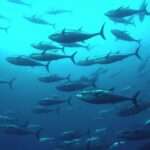Save €20 on a 30-min jet ski rental in Malta this October! Fewer boats, safer waters, and stunning views. Book now with code BWJR.
Category: Malta Excursions
Tuna Fishing in Malta
Malta’s tuna fishing and fish farm industry, its economic importance, and the balance between growth and sustainability.
Dolphins and Whales in Malta
Discover the magic of dolphin & whale watching in Malta. Learn about risks, sightings & book a boat with Bluewaves Watersports for your sea adventure.
Boat Charters in Malta
Boat charters in Malta, Gozo & Comino with Bluewaves Watersports. Luxury boats, events & custom routes.
Best Jet Ski Safari in Malta
Malta’s best Jet Ski Safari with top quality jet ski, expert guides, stunning views, swimming and zooming in search of the Bluewaves Rush.
Cruise to Blue Lagoon Comino
Cruise to Comino’s Blue Lagoon with Bluewaves Watersports. Swim, snorkel & explore stunning bays. Choose from 3 Bay, 2 Bay, or Sunset Cruises.
Echoes of the Azure Window in Gozo
The legacy of the Azure Window and Gozo’s stunning coastline on the Waves of Heritage tour with Bluewaves Watersports.
Ggantija Temples in Gozo
Ggantija – The Prehistoric Megalithic Temples of Gozo On the small island of Gozo, just a short ferry ride from Malta, visitors can discover one of the most astonishing archaeological sites in the world: the Ggantija Temples. These ancient structures are not only older than the pyramids of Egypt and Stonehenge but also represent a time when early human communities created sacred spaces with remarkable skill and purpose. Despite their global historical significance, Ggantija remains a lesser-known marvel, offering travelers a rare chance to experience a truly ancient site without the crowds. A Glimpse into Prehistory The Ggantija Temples are part of the UNESCO World Heritage listed Megalithic Temples of Malta and are considered among the earliest free standing stone structures on Earth. Dating back to between 3600 and 3200 BCE, these temples were constructed during the Neolithic period, also known as the Temple Period in Maltese prehistory. The name “Ggantija” comes from the Maltese word ggant, meaning “giant.” According to local legend, the massive stones used to construct the temples were carried and erected by a giantess named Sunsuna, who was said to have built the temple while carrying a child on her shoulder. Although folklore has long attributed the site to supernatural beings, archaeological evidence confirms the builders were part of a highly organized and spiritual society with a sophisticated understanding of architecture, astronomy, and ritual. Location and Layout of Ggantija Located on the outskirts of the village of Xagħra in Gozo, Ggantija is composed of two main temples enclosed within a single boundary wall. This outer wall, made up of colossal limestone blocks, some weighing over 50 tons, is an awe inspiring sight that immediately invokes wonder. How did people without modern machinery move and place these stones with such precision? The exact methods remain a mystery, but archaeologists suggest the use of spherical stone rollers and levers. Each of the temples features a clover leaf layout known as a trefoil design, consisting of semicircular apses branching off from a central corridor. This design is characteristic of Maltese temple architecture and appears across other prehistoric sites on the islands. The inner sanctuaries were likely used for ceremonial and religious purposes, possibly involving fertility rituals and offerings to deities. Spiritual Significance of the Ggantija Temples While Gozo is also known for its many beautiful churches, such as the Basilica of Ta’ Pinu, the Ggantija Temples offer a much older glimpse into the island’s sacred history. Archaeological findings such as altars, hearths, and animal bones suggest that Ggantija was a site of communal worship and ritual. The temples may have been dedicated to a mother goddess or fertility cult, as implied by figurines and statues unearthed in the area. The emphasis on round, voluminous forms in the statues aligns with fertility symbolism found in other ancient cultures. The orientation of the temples also holds astronomical significance. The southern temple’s main entrance is aligned with the solstices, suggesting that the builders had an understanding of celestial patterns, possibly linking their CONTINUE READING
Um El Faroud Wreck
The Um El Faroud Wreck Malta is renowned for its stunning dive sites, and one of its most iconic wrecks is the Um El Faroud. Resting off the coast of Wied iż-Żurrieq, this wreck is a must-visit destination for divers seeking an exciting and immersive underwater experience. Once a mighty Libyan oil tanker, the Um El Faroud met a tragic fate before being repurposed as an artificial reef. Today, it attracts thousands of divers annually, offering a unique blend of history, marine life, and exploration. The History of Um El Faroud The Um El Faroud was built in 1969 in England and served as an oil tanker for Libya. Measuring 110 meters in length and 16 meters in width, it was a formidable vessel used for transporting fuel across the Mediterranean. However, its operational days came to an abrupt end in 1995 when a devastating accident occurred during maintenance work at the Malta Drydocks. A gas explosion on board tragically killed nine Maltese workers, leading to the vessel being deemed beyond repair. In honor of the lives lost, a plaque is placed on the wreck as a tribute. After spending three years docked at the Grand Harbour, the Maltese authorities decided to scuttle the ship in 1998 to create an artificial reef. The wreck now lies approximately 36 meters deep, making it accessible to advanced divers looking for an extraordinary dive experience. Diving the Um El Faroud Wreck Location and Conditions The Um El Faroud wreck is located just off the coast of Wied iż-Żurrieq, near the famous Blue Grotto. The wreck sits on a sandy seabed at a depth of 35-36 meters, while the highest point of the ship is at around 18 meters. The waters around the wreck generally offer excellent visibility, ranging from 20 to 40 meters, allowing divers to fully appreciate the grandeur of this sunken giant. Google Map location. Exploring the Wreck Diving the Um El Faroud is an unforgettable experience. The ship is split into two sections due to storm damage in 2005, which adds to its dramatic and haunting beauty. Divers can explore the engine room, cargo holds, bridge, and walkways, all of which are now home to a variety of marine life. For those with appropriate wreck penetration training, there are several safe entry points that allow for an eerie yet fascinating exploration of the ship’s interior. However, the depth and size of the wreck make it best suited for advanced and technical divers. If you want to book a diving trip to explore the Um El Faroud Wreck, contact Dive Vision Malta. Marine Life and Biodiversity Over the years, the Um El Faroud has evolved into a thriving artificial reef, supporting an incredible variety of marine life. Schools of barracuda, amberjack, and bream are often seen circling the wreck, while moray eels and octopuses hide within the crevices. The ship’s surfaces have been colonized by colorful sponges, corals, and algae, creating a vibrant underwater landscape. Divers also frequently encounter groupers, CONTINUE READING
Dive Vision Malta
Best dive sites with Dive Vision Malta. Enjoy top-notch facilities, expert instructors & exciting boat rides. Partnered with Bluewaves Watersports












